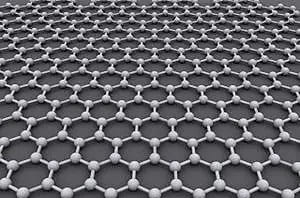Graphene is hailed as one of the strongest materials in the world, owing its remarkable strength to its unique structure and atomic arrangement. As a single-layer, two-dimensional material composed of carbon atoms, graphene exhibits extraordinary mechanical properties, garnering widespread attention from both the scientific and industrial communities.
The Graphene’s Atomic Structure
Graphene consists of carbon atoms arranged in a two-dimensional honeycomb lattice. Each carbon atom forms strong covalent bonds with three neighboring atoms, resulting in a hexagonal arrangement that provides unparalleled stability at the atomic level. Furthermore, graphene's sp2 hybridization of carbon atoms enables efficient electron delocalization, enhancing its electrical conductivity.

Graphene’s Atomic Structure
Graphene's two-dimensional structure contrasts with the three-dimensional structures of other materials.
- Metals: Metals typically have three-dimensional structures where atoms are arranged in various ways to form crystalline structures. In contrast, graphene's two-dimensional structure lacks grain boundaries and defects, enhancing its mechanical properties.
- Ceramics: Ceramic materials also often have three-dimensional structures, such as ceramic crystals or amorphous structures. Unlike graphene, ceramic materials' structures may contain grain boundaries and defects, which can affect their mechanical properties.
- Polymers: Polymers are high molecular weight compounds composed of repeating units, typically with chain-like or network structures. Compared to graphene, polymer structures are more complex, resulting in mechanical properties that may not be as superior as those of graphene.
The Mechanical Strength Properties Of Graphene
Exceptional Strength | Graphene possesses extraordinary tensile strength, surpassing that of steel and even diamond. Its unique atomic structure, consisting of strong covalent bonds between carbon atoms, contributes to this exceptional strength. |
Flexibility | Despite its incredible strength, graphene is also highly flexible. Its two-dimensional structure allows it to bend and stretch without breaking, making it an ideal candidate for flexible electronics and wearable devices. |
Lightweight Nature | Graphene is exceptionally lightweight due to its single-layer atomic structure. This property, combined with its strength, makes it an attractive material for aerospace applications, where weight reduction is critical. |
In addition to its mechanical properties, graphene also exhibits exceptional thermal conductivity. Its high thermal conductivity makes it suitable for applications in thermal management and heat dissipation.
The Applications Of Graphene
Electronics and Optoelectronics:
- Graphene-based transistors and integrated circuits for high-speed electronics.
- Flexible displays and touchscreens enabled by graphene's flexibility and transparency.
- Graphene-based photodetectors and light-emitting diodes (LEDs) for optoelectronic devices.
- Due to its high thermal conductivity and electrical conductivity, graphene is poised to become a novel thermal interface material, overcoming the limitations of aluminum nitride filler due to its inherently low thermal conductivity.
Energy Storage:
- Graphene-based supercapacitors with high energy density and fast charging capabilities.
- Graphene-enhanced lithium-ion batteries for improved energy storage and longer battery life.
Materials Science:
- Graphene-reinforced composites for lighter and stronger materials in aerospace and automotive industries.
- Graphene coatings for corrosion resistance, water purification, and anti-bacterial applications.
Biomedical Engineering:
- Graphene-based sensors for detecting biomolecules and monitoring health parameters.
- Graphene scaffolds for tissue engineering and regenerative medicine applications.
Environmental Applications:
- Graphene membranes for water filtration and desalination.
- Graphene-based catalysts for environmental remediation and pollution control.
In conclusion, graphene's remarkable properties are set to revolutionize industries and drive innovation. As it transitions into practical applications, its transformative impact across sectors becomes evident. With its potential in electronics, energy, materials, biomedical engineering, and environmental sustainability, graphene promises a future of boundless possibilities.
Heeger Materials is a reputable supplier offering top-notch Technical Ceramics products at competitive prices, which are widely used in interventional medicine. If you're interested, feel free to reach out to us at [email protected] for a quote, and we guarantee a response within 24 hours.


